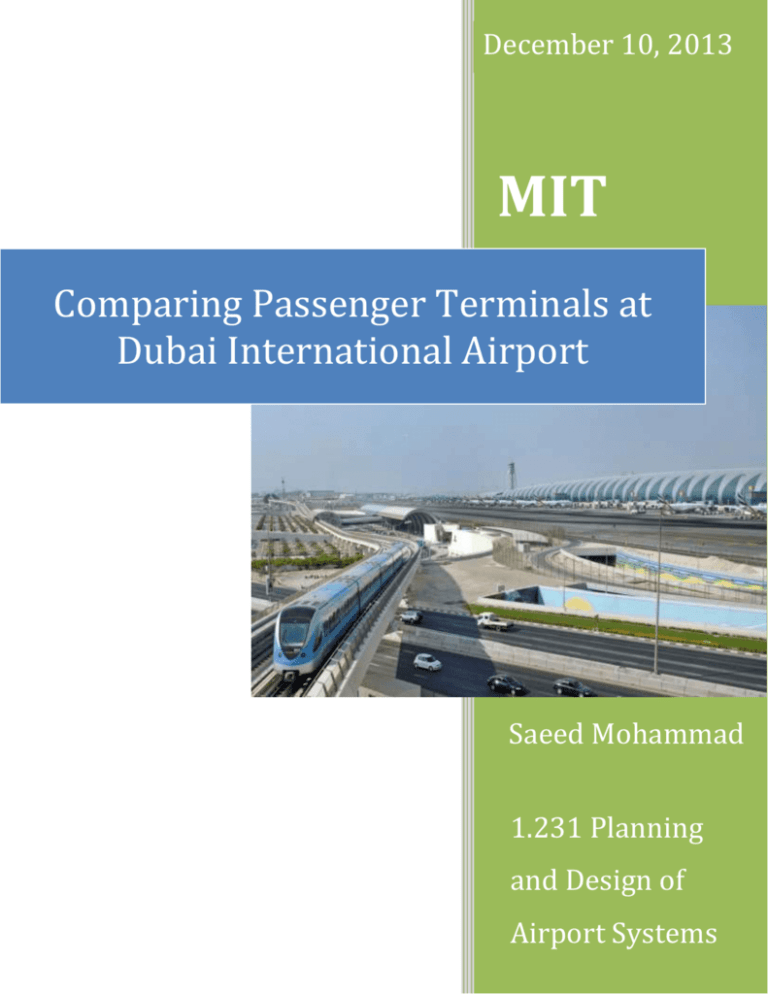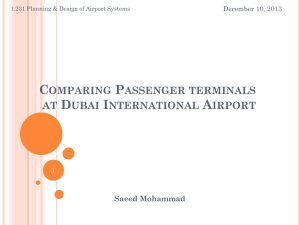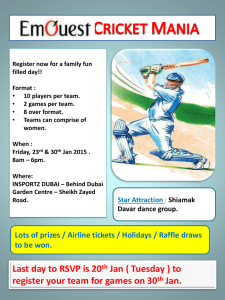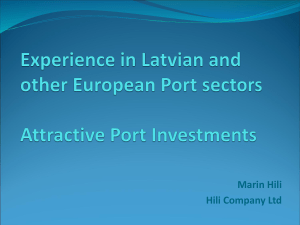Saeed Mohammad - Richard de Neufville
advertisement

December 10, 2013 MIT Comparing Passenger Terminals at Dubai International Airport Saeed Mohammad 1.231 Planning and Design of Airport Systems Contents 1. INTRODUCTION ................................................................................................................. 2 1.1 WHAT IS THE OBJECTIVE OF THIS REPORT? ....................................................... 2 1.2 WHY IS THIS TOPIC IMPORTANT? ............................................................................ 2 1.3 HOW WILL THE TERMINALS OF THE DXB AIRPORT BE COMPARED? ........ 2 2. BACKGROUND .................................................................................................................... 3 2.1 DUBAI.................................................................................................................................. 3 3. DUBAI AIRPORTS ............................................................................................................... 4 3.1 DUBAI INTERNATIONAL AIRPORT (DXB) ............................................................... 4 3.2 AL MAKTOUM INTERNATIONAL AIRPORT (DWC) .............................................. 4 4. ACCESS TO AND FROM DXB TERMINALS ................................................................. 6 4.1 TERMINAL 1 ACCESS ..................................................................................................... 6 4.2 TERMINAL 2 ACCESS ..................................................................................................... 6 4.3 TERMINAL 3 ACCESS ..................................................................................................... 7 5. DXB TERMINAL DESIGN ................................................................................................. 9 5.1 TERMINAL 1 DESIGN ..................................................................................................... 9 5.2 TERMINAL 2 DESIGN ................................................................................................... 17 5.3 TERMINAL 3 DESIGN ................................................................................................... 18 6. EXPO 2020 ........................................................................................................................... 24 7. RUNWAY CLOSURE ........................................................................................................ 24 8. OVERALL ........................................................................................................................... 25 9. REFERENCES .................................................................................................................... 27 1 1. INTRODUCTION 1.1 WHAT IS THE OBJECTIVE OF THIS REPORT? This report aims to compare the current conditions of passenger terminals at Dubai International Airport (DXB). This report will focus on analyzing two major aspects, access to the terminals and design of terminal buildings, with an emphasis on the latter aspect. 1.2 WHY IS THIS TOPIC IMPORTANT? The importance of comparing the passenger terminals at DXB airport is threefold. First, the airport has tremendously grown over a relatively short time period thus experiencing a rapid growth in passenger activity. Second, the airport annually transfers millions of passengers as it is an international hub. Third, the airport plays a major role in supporting Dubai’s economy by accommodating millions of passenger every year, especially businessmen and tourists who are becoming increasingly attracted to Dubai. 1.3 HOW WILL THE TERMINALS OF THE DXB AIRPORT BE COMPARED? The methodology followed in this report will focus on Terminals 1 and 3. The report will compare and contrast the two terminals and discuss the reasons that shape the design of each terminal. Terminal 1 and Terminal 3 are being compared because those two terminals both significantly enhanced the passenger capacity of DXB airport in 2000 and 2008, respectively. Terminal 2 will only be briefly discussed since it serves a very different purpose. It should be noted that this report will mainly base its content on the 1.231 Planning and Design of Airport Systems class notes and discussions, the 2013 edition of the Airport Systems Planning, and Management book, as well as data and reports gathered from online sources. 2 2. BACKGROUND 2.1 DUBAI Dubai is a city in the United Arab Emirates with a total population of around 2 million people1. The city has grown rapidly over the last few years as is indicated by the increase in population from 1.3 million in 2005 to 2.1 million in 2013. Its geographic location has made it a good connector of flights. Note that according to the aviation sector in Dubai is responsible for 28% of Dubai GDP2. It should also be recognized that Dubai Airports had 3,348 employees by the end of 20123. Figure 1: Dubai’s location in World Map4 1 http://www.dsc.gov.ae/Pictures/InfoGraphics/infographic-people-B.pdf Oxford Economics: Explaining Dubai’s Aviation Model 2011 3 Dubai Airports: Yearbook 2012 4 Image from Dubai Airports: Strategic Plan 2020 2 3 3. DUBAI AIRPORTS 3.1 DUBAI INTERNATIONAL AIRPORT (DXB) The first airport in Dubai was opened in 1960, in an empty area considered to be the edge of Dubai at that time. Many developments of the airport occurred afterwards, but perhaps the most important of those was the opening (or expansion) of Terminal 1, which opened in the year 2000, cost around 540 million US dollars, and increased the passenger capacity of the airport from 10 million to 23 million passengers per year. Then in 2008, Terminal 3 was opened, at a cost of 4.5 billion US dollars, to increase the passenger capacity to 60 million passengers per year. It should be noted that Terminal 3 was dedicated to only Emirates airlines in 2008. Then in early 2013, Concourse A in Terminal 3, which cost approximately 3.3 billion US dollars, was opened to increase the passenger capacity to 75 million passengers per year. As for Terminal 2, it was opened in 1998, cost 400 million US dollars, and added a passenger capacity of 2 million, but because of its small size as it only serves scheduled, charter, and special interest flights, it will not be discussed in too much detail in this report. It is interesting that most of the boost in airport capacity occurred over the last 15 years, even though the airport had been there since 1960. 3.2 AL MAKTOUM INTERNATIONAL AIRPORT (DWC) This DWC airport is located approximately a distance of 70 kilometers from Dubai International Airport. The airport is located in a complex named Dubai World Central, which will be home to six zones: Al Maktoum International Airport, Dubai Logistics City, Commercial City, Residential city, Aviation City, and Golf City. This airport was opened in June 2010 for cargo operations, while the passenger terminal was opened for service in 2013 and currently has the capacity of carrying 5 million passengers per year. The airport has a second construction phase, in which the passenger capacity is planned to increase to 160 million passengers per year. DWC airport is expected to be completed in 20275. It is estimated the cost of the entire complex of six zones will cost more than 32 billion US dollars. This airport is connected to the city of Dubai and DXB airport through roads. In other words, currently the only way to get to the DWC airport is on rubber-wheeled vehicles (cars, buses). 5 http://www.cnn.com/2013/10/28/travel/dubai-new-airport/ 4 DXB DWC Figure 2: The location of each of the two international airports6 Figure 3: Al Maktoum International Airport in the Dubai World Central Master Plan7 6 7 Image from google maps. Note that the red and green lines on the map represent transit Metro lines. Image from http://www.dwc.ae/project-details/ 5 4. ACCESS TO AND FROM DXB TERMINALS 4.1 TERMINAL 1 ACCESS Terminal 1 at DXB airport has a total of 2,593 parking spaces allocated to the public, 174 parking spaces allocated to the airports staff, 46 parking spaces for limousine cars, 34 parking spaces for buses, and 8 parking spaces for taxis. In addition to the above, the Red Line of the Metro has a station at Terminal 1. The station is connected to Terminal 1 by a building skywalk bridge, meaning that passengers do not have to exit into the heat before entering Terminal 1. Figure 4: Metro station connecting Terminal 18 4.2 TERMINAL 2 ACCESS Terminal 2 is the smallest of all three terminals and we therefore expect less accessibility to be given to this terminal. There are 1073 parking spaces allocated for the public at this terminal and 23 parking given to car rental services. Note that the parking spaces are 8 Image from http://www.dubaiairport.com/en/media-centre/Pages/imagesTerminal1.aspx 6 significantly less than the spaces provided in Terminal 1. In addition, as expected, the Metro does not directly connect to Terminal 2. 4.3 TERMINAL 3 ACCESS Terminal 3 provides 1,889 parking spaces allocated to the public, 163 car rental parking, and 44 Emirates bus parking. In addition, similar to Terminal 1, the Red Line of Dubai Metro connects directly to Terminal 3. Note that the differences between Terminal 1 and Terminal 3 provide insights about the types of travelers. First, Terminal 3 has less public parking spaces. This indicates two that Terminal 3 travelers are more likely to be tourists or business travelers since they do not generally expect someone to greet them at the airport when they depart or arrive. Second, Terminal 3 has more spaces allocated to car rentals. This indicates the higher willingness to pay and perhaps the greater length of stay in Dubai. Third, Terminal 3 has 44 dedicated Emirates buses, indicating the robust service provided to Emirates’ customers. Figure 5: Metro station connecting to Terminal 39 Five items should be noted about the discussion of the three Terminals. First, the public parking spaces are priced and have limitations to the duration of parking. Second, for transit passengers, the transfer between Terminal 1, 2, and 3 takes around 15 to 25 minutes.10 Third, as 9 Image from http://www.dubaiairport.com/en/media-centre/Pages/imagesTerminal3.aspx http://www.dubaiairport.com/en/media-centre/facts-figures/Pages/factsheets-reports-statistics.aspx?id=5 10 7 is the case in most major airports around the world, the largest portion of travelers prefer taking rubber-wheeled transportation to the airport due to reliability, flexibility, comfort, and accessibility. In other words, personal cars, taxis, and buses appear to be more preferred than the Metro. Fourth, even with the general preference of rubber-wheeled transportation, the Red Line station at Terminal 1 has been a growth from around 560,000 trips in 2010 to approximately 1.4 million trips in 2012, and Terminal 3 station has seen a smaller growth from around 740,000 trips in 2010 to approximately 880,000 trips in 2012.11 Fifth, the Metro is a fully automated driverless system, which increases (or decreases, depending on how much trust in technology a traveler has) the reliability of the service to the airport. 11 Note that the Red Line opened in September 2009. Data retrieved from http://dsc.gov.ae/EN/Themes/Pages/Reports.aspx?TopicId=11 8 5. DXB TERMINAL DESIGN It is first important to note the general trend that DXB airport has experienced over its life. The figure below provides a good description. Note that in 2012 (not shown in figure below) the number of annual passengers was almost 57.7 million passengers, and that the current capacity is 75 million passengers per year, meaning that there is still enough existing capacity for more than 10 million passengers. Figure 6: The evolution of passengers in DXB airport since 196012 5.1 TERMINAL 1 DESIGN There are around 100 airlines operating at this terminal, which has a capacity of handling 20 million passengers per year. Each of the levels in this terminal is discussed in further detail below. 12 Dubai Airports – Strategic Plan 2020. http://www.dubaiairport.com/en/media-centre/Pages/Reports.aspx 9 Figure 7: Map of Terminal 1 Check-In area13 There are a number of major aspects to notice about the above map. First, there are 12 two-way entry/exit points to the building, which is an abundant number for everyday travel as well as in cases of emergencies. Of the 12 entry points, 1 is dedicated to the Metro Red Line, and 2 (check-in area F) are dedicated to business-class and first-class travelers. Second, the location of the “Airport Information” counter is roughly in the middle of the building. Such a location is chosen in order to reduce the average walking length of passengers in case they have any questions. Third, restaurants are located on the second floor of the building. This is done in order to avoid having clusters of non-passengers blocking the path of passengers trying to catch their flight. Fourth, 2 Duty Free shopping stores are placed at the edges of the entrance to the building, 1 store is located after check-in, and 1 store placed on the second floor. The 2 stores at the edges 13 Image from http://dubaiairportsreview.com/ 10 of the building are aimed to capture passengers who are not in a hurry but perhaps forgot something. Also note that the store on the left is next to the entry point of the Metro, since those using the Metro are expected to be in less of hurry than others. The store on the second floor aims to capture the attention of passengers that have enough time to actually buy electronics and other items. The store located after the check-in counters is meant to address passengers who need to quickly get something and then run to their soon-to-depart flights. Fifth, the distribution of the currency exchange cubicles is similar14 to the Duty Free stores. Sixth, restrooms are positioned almost evenly along the linear distance of the building. Such a distribution is logical as it is considered a necessity rather than a luxury. Seventh, note that only passengers are allowed to enter the check-in areas A through F, meaning that all the services provided prior to check-in can be used by both passengers and non-passengers. In addition, note that the check-in areas have a total of 63 check-in counters and provide a large space allowing high passenger flows. Furthermore, seating is provided in the center of the checkin areas15 to accommodate elders and children who need to rest as their responsible person processes their check-in procedures. Eighth, notice that the medical center is positioned after the check-in desks. In other words, if a passenger needs medical assistance while or after checkingin, he/she can be immediately assisted. The fact that there is only one such facility indicates that the cases of necessary medical assistance in this terminal are thankfully low. Ninth, passengers from check-in areas A through E all go through one corridor to enter the immigration areas. This distribution causes some delays at the red circle pointed in Figure 6, which can be considered a bottleneck in this system—this could be an area to improve at this terminal. The passengers then dissipate as there are numerous immigration desks and security desks afterwards. Next the passengers then move down using stairs, escalators, and elevators. Finally, the passengers reach a wide, lengthy (300 meters in length) underground passage connecting the check-in area to the departure gates. The passage has moving walkways as well as golf carts as a service for those unable to walk or stand for long distances. 14 15 Similar in the sense that they try to capture passengers in a hurry and the more relaxed passengers. Not shown in maps. The seats I remember from personal experience. 11 Figure 8: Map of Terminal 1 Departure Gates (C Gates)16 Passengers then arrive at the lower level of the C departure gates. In other words, the passengers now immediately arrive into the Duty Free area. Notice three things about this level. First, it is entirely reserved for Dubai Duty Free. This explains the success of Dubai Duty Free as it can be viewed as a monopoly in this situation. Second, the restrooms are located at the edge on this level. This means that a passenger will necessarily pass by multiple stores before reaching the restroom. Third, this floor is completely separated from the floor with the departure gates. This is very important because otherwise, the “attractions” will generate high demand and perhaps create clusters and hotspots, which could disrupt the flow of passengers wanting to arrive at their gate as soon as possible. However, this could have a negative impact on passengers who are travelling from gates C1 or C44 for instance, because such passengers have a long distance to cover to their gates and might not spend much time at the Dubai Duty Free. 16 Image from http://dubaiairportsreview.com/ 12 As for the actual departures building, notice it is built in a linear manner. It is 800 meters long and has multiple moving walkways midway between the northern and southern sides. Note that, regardless of the physical structure of the building, the distribution of facilities (i.e. currency exchange, medical center, foods, stores, airport information, restrooms) follows similar characteristics mentioned above. In other words, most of the facilities are located in areas that target most passengers as well as different types of passengers (i.e. those in hurry and those more relaxed). For non-transit passengers, the service provided and passenger flows at this level are doing well. However, there are potential locations which can disrupt passenger flows. For example, during boarding, lines of passengers back-up and block the flow of other passengers going to the flowing gates. Because there are moving walkways, the length of these lines is physically constrained, and hence semi snake queues begin to form. It appears to me that if snake queues are implement by the airport management, it would relief some of such hotspots. An important thing to note is the hotel in the center (between gates C15 and C17). The hotel offers 88 rooms, a health club, a gym, a swimming pool, massage, and many other services. Offering such services in an airport is quite intriguing, and it seems to be mainly aimed at transit17 passengers staying for long periods or perhaps overnight. There is another aspect regarding transit travelers. Notice that at the lower left of the Duty Free floor, there is an interterminal bus connection. These travelers have access to B gates (on the far right of Figure 7). B gates are located in Terminal 3. In other words, passengers connecting to Emirates flights have a direction access point to the Emirates Terminal 3. 17 Transit passengers are those that have connecting flights and are temporarily staying in Dubai airport. 13 Figure 9: Map of Terminal 1 Arrivals/Connections18 Notice that in Figure 8, the design of the building looks similar to the design of a highway. In other words, it is a one directional flow (with moving walkways) with services (i.e. restrooms, ticket sales desks, etc…) and exits on the sides. Hence, passengers arriving at Terminal 1 have three options as the move towards the right in Figure 8. First, they can go to the departures level discussed previously and shown in Figure 7. Second, they can go immediately to Emirates Terminal 3 as noted at the far right of Figure 8. Third, they can go to baggage claim and afterwards exit the airport. Below we will further discuss the third option. 18 Image from http://dubaiairportsreview.com/ 14 Figure 10: Map of Terminal 1 Arrivals19 Passengers now have to walk (or use the moving walkway) the 300 meter underground passage to arrive at the area shown in Figure 9. This building is the same building where departing passengers check-in. There are multiple points to dissect in this area. First, the passengers are met with a variety of services such as Arabian Adventures. This indicates the marketing and tourism nature of this terminal and the DXB airport in general. Second, passengers can either go through the traditional passport control desks or through the E-Gates. It should be noted that most passengers are not eligible to go through the E-Gates. Another thing to note is that some of the passport control desks are allocated to UAE nationals, but is also frequently utilized to serve non-UAE nationals especially during peak hours. Third, snake queue lines are not used in this area, so at rush hour the queues appear to be quite long. This is a 19 Image from http://dubaiairportsreview.com/ 15 location where such an idea might speed up the service rate. Fourth, at this location, a medical facility is available in case a passenger requires medical assistance. All passengers that pass the passport control desks go through a security check and then are met with a Dubai Duty Free store. The store’s location is strategic because passengers can spend time at the store as they wait for their baggage to arrive. Note that carousel 9 is much further than carousel 1 and that there are no moving walkways. It appears that the physical space or high cost were a limiting factor in this case. In other words, it would have been more efficient to have a “square” in which carousel 1 would be facing carousel 9, carousel 2 would be facing carousel 8, and so on. After baggage claim, passengers who declare carrying food items go through another security checkpoint, while other passengers could be randomly selected to go through that security checkpoint as well. The walkways afterwards are rather wide and lead to exiting the airport, where many forms of transportation (taxis, Metro, buses) await travelers. Finally, another point to notice is that non-passengers have a waiting area allocated to their use. The lower right-corner of Figure 9, where Starbucks and Costa are located, are waiting areas that are directly connected to the Metro Red Line. This area is rarely crowded and does not face any space or capacity issues. 16 5.2 TERMINAL 2 DESIGN This terminal is home to Dubai’s low cost airline flydubai. The terminal also serves around 50 other airlines and has a capacity of 5 million passengers per year. The terminal is undergoing expansion and will have a capacity of 10 million passengers per year after the expansion. Note that because this terminal is strikingly different than Terminal 1 (and Terminal 3) and will therefore not be discussed in detail. Figure 11: Map of Terminal 220 Some major features to notice about this terminal include the bus and taxi services connecting to this terminal, the compactness of the check-in, departures, and arrivals areas, the visibility of a Dubai Duty Free store in the departures area, the existence of a medical facility in the departures area, and the connecting shuttles to Terminals 1 and 3. 20 Image from http://dubaiairportsreview.com/ 17 5.3 TERMINAL 3 DESIGN When Terminal 3 was opened in 2008, it was dedicated solely for use by Emirates airlines. However, starting April 201321, Qantas and Emirates airlines formed a global partnership and they now both share the use of Terminal 3. The current passenger capacity of Terminal 3 is more than 55 million passengers per year. In addition, Concourse D is undergoing construction and will be completed by 201522, has a capacity of carrying 18 million passengers per year. In total, by 2018, Dubai airports will increase their passenger capacity to 90 million passengers per year. Figure 12: Map of Terminal 3 Check-In23 Numerous features of this area can be dissected. First, notice that the building and check-in area in this terminal are designed quite differently than the building and check in area in Terminal 1. 21 http://www.qantas.com.au/travel/airlines/qantas-emirates/global/en?int_cam=au:info:promo:qantasemirates:lang:en 22 http://www.thenational.ae/business/industry-insights/energy/dubai-airports-concourse-d-to-use-solar-power 23 Image from http://dubaiairportsreview.com/ 18 This indicates that the building is expected to be used by different types of users. Second, this building has only 5 entry/exit points, which is much less than the 12 entry/exit points in Terminal 1. However, with the exception of the Metro entry point, each of the 4 entry points in this building is more around twice the width of an entry point in Terminal 1. In other words, the size of the entry points recovers the number of entry points and is therefore adequate in general and in cases of emergencies. Third, note that there are a few extra service offered in this building such as self-check-in kiosks and E-gates. Such services are provided because passengers on Emirates airlines expect to be given such privileges. Fourth, similar to Terminal 1, business class and first class passengers are given their own separate check-in counters. This behavior is similar in many worldwide airports, but the difference here is that the business class and first class building is almost separated from the economy, which is not common globally. This design again shows that the high service provided to business class and first class travelers. Fifth, it is interesting that in general, shopping services appear to be less concentrated in this building. It seems that the marketing focus is not much dedicated to pre-check-in. Sixth, in juxtaposition to Terminal 1 check-in area, passengers and non-passengers are allowed to enter the check-in area with no restrictions. This can be done in this building because all flights are on Emirates, which reduces the possibility of customer confusion, and because the building has simply more floor area for people. Seventh, moving walkways are provided in between the check-in counters on each side. This is done to reduce the walking time for passengers in a hurry. Eighth, similar to Terminal 1, seats are provided by the moving walkways. Such seats are for elders and children who perhaps have difficulty waiting in line to check-in. Ninth, services like airport information, restrooms, restaurants, and medical center are generally distributed away from the main passage. This is done in order to avoid having passenger flows disrupted by nonpassengers. Finally, the red circle in Figure 11 is a point where I think delays can occur. It does not seem to me that the fence is necessary from a design perspective. Note that there are around 126 counters for economy travelers, and about 36 self-check-in kiosks. The major difference is the number of self-check-in kiosks that were not available in Terminal 1. 19 Figure 13: Map of Terminal 3 Departures Gates (A Gates)24 The general characteristics shown in Figure 12 are not drastically different than the characteristics of the departure gates of Terminal 1. However, there are some significant differences. First, note that the Dubai Duty Free is on the same floor as the gates. This is advantageous for travelers since they can now shop in close proximity to their departure gate, not having to worry about missing a flight. Such a design can be done only when there is enough physical space, otherwise, the Terminal 1 design is sufficient. Second, the stores and services and more compact. It appears that the design in this case was no focused on providing centralized moving walkways, but rather a few moving walkways in certain locations. Third, the hotel in this terminal has 253 rooms with other amenities like a swimming pool and a gymnasium. Notice that the number of rooms here is almost 3 times as much as the number of rooms in Terminal 1. Fourth, there is an airport train that connects to 24 Image from http://dubaiairportsreview.com/ 20 gates B, C, D, and F, and there are buses on both ends of the terminal that connect to gates C, D, and F. In the case of Terminal 1, there was no airport train available and the bus stop was only in one location around the center of the terminal. Finally, notice that there are two medical facilities in this building, as opposed to the only 1 medical facility in Terminal 1 departure gates. Figure 14: Map of Terminal 3 Departures Gates (B Gates)25 The overall design of this departure gates is similar to the departure gates A except in two major aspects. First, the stores and services in this area are less compact. This allows for a more freedom of movement for passengers. Second, the number of moving walkways is significantly higher. Basically, a passenger can walk through most of this departure terminal on moving walkways. 25 Image from http://dubaiairportsreview.com/ 21 Figure 15: Map of Terminal 3 Arrivals/Connections26 Passengers arriving at this terminal can either go for a connecting flight or to baggage claim. Note that the passengers are moving towards the left in Figure 14. Connecting passengers have to go up a level, whereas terminating passengers should go down to the lower level. The design of this building is similar to the general design of Terminal 3. However, as expected, there are not many services27 provided at this level because this is not an area where passengers are expected to cluster. Passengers connecting go the departures level at B gates, which was discussed previously and illustrated in Figure 13. Passengers terminating in Dubai go to the arrivals level, which is discussed below. 26 27 Image from http://dubaiairportsreview.com/ Essential services such as restrooms and medical centres are naturally provided. 22 Figure 16: Map of Terminal 3 Arrivals28 Passengers that are arriving in Dubai terminate in this area. There are a number of differences between this area and the arrivals at Terminal 1. First, notice that the passport control desks are distributed more evenly. This distribution can accommodate more passengers and thus provide quicker service. In addition, this distribution allows for a more compact positioning of passengers such that flows are not disrupted by queues. Second, note that the medical center is located after the passport control desks, as opposed to Terminal 1 where it was located before the passport control desks. Third, the baggage carousels (14 as opposed to 9) are now evenly distributed and there are moving walkways in between the two sides of carousels. In other words, the walking distance for all passengers is the same regardless of which carousel holds their baggage. 28 Image from http://dubaiairportsreview.com/ 23 Fourth, the Dubai Duty Free store is located at the end of the passenger’s trip. This positioning is exactly opposite to Terminal 1’s positioning. In this terminal, it is expected that once passengers collect their luggage they can then shop at the Duty Free without being anxious for their baggage’s arrival. This also means that Emirates aims at reducing the baggage waiting time, otherwise passengers would be less likely to shop at the Duty Free. There are some similarities between the arrivals at Terminal 1 and Terminal 3. Notice that when passengers exit the final security checkpoint, they are directed down a passage which has car rental, hotel, tour, and other booths that attract both leisure and business travelers. In addition, the non-passenger waiting area has little services because it is generally not a crowded area. 6. EXPO 2020 Thankfully Dubai will be hosting EXPO 2020. It is announced that the Expo facilities will be located in Dubai World Central29. This is a very exciting even that will add much to Dubai and Dubai Airports. Since this was recently decided, it will be intriguing to see how the DXB and DWC airports are going to act in order to accommodate the additional millions of passengers that will be arriving in 2020. Although the capacity of DXB airports will be 90 million passengers per year by 2018, the surge in passengers over a relatively short time period will need deep and thoughtful strategies aimed at providing a high quality of services to millions of passengers with various levels of expectations and different cultures. 7. RUNWAY CLOSURE The southern runway at DXB airport will be closed for around 30 days (from May 1, 2014 to May 31, 2014) and then northern runway will be closed for around 50 days (from May 31, 2014 to July 20, 2014) for refurbishments. These closures are aimed at improving the conditions of the runways as they reach their design life. Meanwhile, construction has already begun to add a taxiway as well as rapid taxiways as a means of reducing the impacts of the runway closure on aircraft movements. It is estimated that around 28% of capacity will be lost due to the runway closure30. 29 30 http://expo2020dubai.ae/en/hello_2020/article/a_masterplan_symbolizing_the_enduring_values_of_expo http://www.dubaiairportsconnect.com/news/work-on-taxiway-to-ease-runway-closure/ 24 8. OVERALL The dynamic nature of passenger terminals at hub airports is a very interesting topic. Two major components shape passenger terminals: access to the terminal and the design of the terminal building. In this report, the focus was on the design of the building. In this paper, the passenger terminals of Dubai International Airport (DXB) were analyzed. DXB airport was chosen because of its rapid growth of the past 15 years and because the aviation sector in Dubai is estimated to have a 28% impact on Dubai’s GDP. It is also noteworthy to recognize the Dubai Airports have 3,348 employees in total. There are three terminals in DXB airport. Terminals 1 and 3 were compared in detail because they both added large passenger capacities when built. Terminal 1, which serves about 100 airlines, was opened in 2000 and shifted the DXB airport’s capacity from 10 million to 23 million passengers per year. Terminal 3, which serves Emirates and only recently (April 2013) began serving Qantas, was opened in 2008 and shifted the DXB airport’s capacity to 60 million (and then to 75 million in 2013). Terminal 2 was very briefly discussed because its purpose is very different than the purpose of Terminals 1 and 3. In terms of access, the two terminals have very similar characteristics. Both terminals have large parking space, taxis, buses, rental car services, as well as a dedicated Metro station. One interesting point to recognize is that Terminal 3 has less public parking spaces but more car rental services. In other words, the passengers at Terminal 3 are willing to pay more for services and are more likely to be tourists or leisure travelers than nationals of the UAE. In terms of design, the main difference between the two terminals is in the check-in areas. The check-in area in terminal 1 is designed to accommodate many airlines and is therefore shaped in squares that merge into one corridor for all passengers to walk to their gates. The check-in area in Terminal 3 is designed for Emirates passengers and is therefore shaped into one length rectangle where most passengers walk in one very wide passage towards the gates. The design of departure gates is similar in structure for both terminals. The design of the arrivals area is quite different; Terminal 3 is more efficient especially in the passport control desks and the baggage carousels area. A number of future challenges exist for DXB airports. The Expo 2020 is being hosted by Dubai at Dubai World Central. There currently is Al Maktoum International Airport at Dubai World Central, but it currently only handles 5 million passengers per year. This means that DXB 25 airport will be the main gateway to Dubai during the Expo. It will be interesting to see how a surge in demand will be handled in 2020. In addition, in 2014, the runways at DXB airport will be refurbished for a total of 80 days (30 days southern runway and 50 days northern runway). The reduction in capacity is estimated at 28%. The question is, is it feasible for the management to shift some flights to DWC airports? 26 9. REFERENCES 1. "A Masterplan Symbolizing the Enduring Values Of Expo." Expo 2020, Dubai UAE. Web. 09 Dec. 2013. http://expo2020dubai.ae/en/hello_2020/article/a_masterplan_symbolizing_the_en during_values_of_expo 2. de, Neufville Richard, and Amedeo R. Odoni. Airport Systems: Planning, Design, and Management. New York.: McGraw-Hill, 2013. Print. 3. Dubai Airports. Web. 07 Dec. 2013. http://www.dubaiairports.ae/en/Pages/Home.aspx 4. "Dubai Airport's Concourse D to Use Solar Power | The National." Web. 09 Dec. 2013. http://www.thenational.ae/business/industry-insights/energy/dubai-airportsconcourse-d-to-use-solar-power 5. Dubai Statistics Centre. Web. 07 Dec. 2013. http://www.dsc.gov.ae/en/Pages/Home.aspx 6. "Project Details | DWC." PROJECT DETAILS | DWC. Web. 06 Dec. 2013. http://www.dwc.ae/project-details 7. "Qantas and Emirates." Partnership. Web. 09 Dec. 2013. http://www.qantas.com.au/travel/airlines/qantasemirates/global/en?int_cam=au:info:promo:qantas-emirates:lang:en 8. "Reports and Publications." Dubai Airports – Strategic Plan 2020 Web. 09 Dec. 2013. http://www.dubaiairport.com/en/media-centre/Pages/Reports.aspx 9. "Reports and Publications." Dubai Airports Yearbook 2012 Web. 09 Dec. 2013. http://www.dubaiairport.com/en/media-centre/Pages/Reports.aspx 10. "Reports and Publications." Oxford Economics: Explaining Dubai’s Aviation Model 2011. Web. 09 Dec. 2013. http://www.dubaiairport.com/en/media-centre/Pages/Reports.aspx 11. "Work on Taxiway to Ease Runway Closure - Dubai Airports Connect." Dubai Airports Connect RSS. Web. 09 Dec. 2013. http://www.dubaiairportsconnect.com/news/work-on-taxiway-to-ease-runwayclosure 27 12. "World's Latest Mega-airport Finally Opens to Passengers." CNN. Cha, Frances. Web. 08 Dec. 2013. http://www.cnn.com/2013/10/28/travel/dubai-new-airport/ 28






